Homicide in Scotland, 2011-12
Statistical bulletin on crimes of homicide recorded by the police in Scotland in 2011-12
This document is part of a collection
3. Commentary
Statistics quoted in this section refer to cases currently recorded as homicide, as at 6 November 2012. A case of homicide refers to one incident and may involve more than one victim and/or accused person.
The statistics on homicides are used to inform National Outcome 9 - 'we live our lives safe from crime, disorder and danger' as well as The Strategy for Justice in Scotland. These statistics are also used by a wide range of stakeholders to monitor trends, for policy research and development, and for research purposes.
3.1 Homicide cases (Tables 1, 2, 3 and 4, and Charts 2 and 3)
- In 2011-12, Scottish police forces recorded 88 cases of homicide, a decrease of 11% from the 99 cases recorded in 2010-11. The number of cases recorded in 2011-12 was the lowest in the ten year period covered by this bulletin apart from in 2009-10, when there were 80 homicide cases recorded. As at 6 November 2012, two of the homicide cases recorded in 2011-12 were unsolved.
- Homicide cases involving more than one victim remain rare. There was only one such case in 2011-12, which is similar to the number in previous years. Of the 88 homicide cases recorded in 2011-12, 26% of them involved more than one accused person. There was a total of 124 accused persons connected with the 88 recorded homicide cases, with two cases being unsolved as at 6 November 2012.
- In the Strathclyde Police force area, which contained 42% of the estimated population of Scotland in 2011, there were 51 recorded homicide cases in 2011-12, 58% of the total number of cases. Between 2010-11 and 2011-12 there was a decrease in the number of homicide cases recorded by four of the eight police forces. The forces where the number of recorded homicide cases decreased were Grampian Police, Lothian and Borders Police, Northern Constabulary and Strathclyde Police. The one homicide case reported in the Grampian Police force area is the lowest number of cases for this force in the ten year period covered by this bulletin. The largest decrease in terms of the number of cases was 11 (18%) for the Strathclyde Police force area.
- There were increases in three of the force areas: Central Scotland Police, Fife Constabulary and Tayside Police. Following no homicide cases being reported in the Tayside Police force area in 2010-11 there were ten reported in 2011-12. This is the highest number of cases for the Tayside Police force area in the ten years covered by this bulletin. The number of homicides reported in the Dumfries and Galloway Constabulary force area remained the same as in 2010-11, at one case.
- In 2011-12, the most common location for homicides to occur was within a dwelling (60% of all cases) followed by a street or footpath (25% of all cases). In total 64% of homicides occurred within a residential location, 31% in outdoor public places and 6% in indoor public places. This pattern of homicide locations has remained consistent over the ten year period covered by this bulletin. Chart 2 shows the distribution of homicide cases by location between 2002-03 and 2011-12.
Chart 2: Location of homicide cases, where known, Scotland, 2002-03 to 2011-12
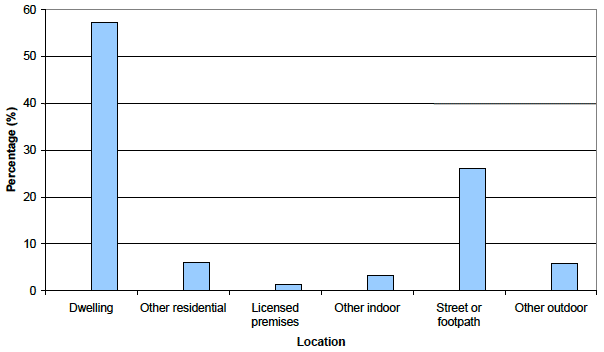
- Homicide cases recorded by the police make up only a very small proportion of all recorded crimes of violence, 0.1% in 2011-12. This has remained broadly consistent over the ten year period covered by this bulletin. It can be seen from Chart 3 that the number of recorded homicides by the police has followed a downward trend over the ten year period from 2002-03 to 2011-12. A similar trend has also been seen for the number of recorded attempted murders and recorded serious assaults. For further information on crimes of violence please see Note 4.13.
Chart 3: Trends in selected non-sexual violent crimes1, Scotland, 2002-03 to 2011-12 (Index 2002-03 = 100)
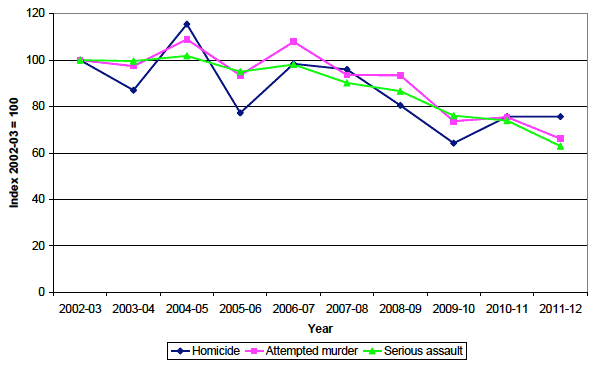
1. The homicide figures provided in this chart were taken from aggregate crime statistics recorded by the police. Due to slight differences in the timing and methods of collection, the aggregated recorded crime figures for homicide may differ slightly from the figures given elsewhere in this bulletin, which are derived from individual returns made in respect of each homicide. For further information on the homicide figures included in this chart please see Note 4.13.
3.2 Victims of homicide (Table 5 and Charts 4 and 5)
- In total, there were 90 victims in the 88 homicide cases recorded in 2011-12, 11 fewer victims than in 2010-11. This represented a rate of 17 victims per million population in Scotland. Chart 4 shows that, although only 29% of the Scottish population between 2002-03 and 2011-12 was aged 31 to 50 years, 42% of all homicide victims were in this age range. Furthermore, the percentage of homicide victims in the 21 to 30 year age range was greater than the relative percentage of the population by 12%. It can also be seen that the percentage of homicide victims in the older age ranges, 51 years and over, constituted only 17% of all victims in the period 2002-03 to 2011-12 compared to the 34% of the population these age ranges made up.
Chart 4: Age profile of homicide victims compared to population1 profile, Scotland, 2002-03 to 2011-12
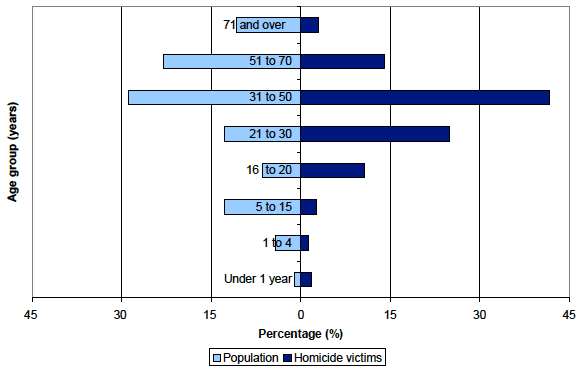
1. Population estimates as at mid year 2011 from the National Records of Scotland
(http://www.gro-scotland.gov.uk/statistics/theme/population/estimates/mid-year/2011/index.html)
- In 2011-12 there were 71 male victims, 79% of all homicide victims. The overall homicide rate for males was 28 victims per million population, four times the rate for females which was seven victims per million population. For each age range the homicide rate per million population was greater for males than females in 2011-12.
- The highest homicide rates recorded in 2011-12 for males were in the 21 to 30 and the 31 to 50 year age groups, 46 and 44 victims per million population respectively. The highest rate for females was in the 21 to 30 year age group, 17 per million population.
Chart 5: Homicide victims per million population1 by age and gender, Scotland, 2011-12
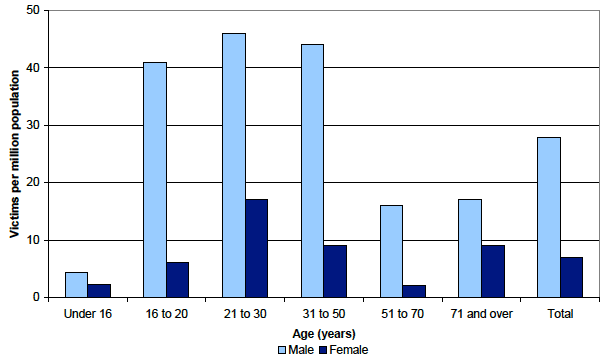
1. Population estimates as at mid year 2011 from the National Records of Scotland
(http://www.gro-scotland.gov.uk/statistics/theme/population/estimates/mid-year/2011/index.html)
3.3 Persons accused of homicide (Table 6)
- Of the 88 homicide cases recorded in 2011-12, 124 persons have been accused as at 6 November 2012, 19 fewer than in 2010-11. This is a decrease of 13% in the number of accused persons. The vast majority of accused persons in 2011-12 were male, 93% of the total. In 2011-12 only nine females were accused of homicide, which is the lowest number of female accused in the ten year period covered by this bulletin and the second lowest percentage of all accused after 2003-04.
- In 2011-12, the total number of individuals accused of homicide equated to 24 per million population. The rate was highest for males aged 16 to 20 years, 148 per million population, followed by males aged 21 to 30 years, 106 per million population. The highest rate for females related to those aged 16 to 20 years, 12 per million population, although it should be noted that the rates for females are based on relatively small numbers of accused.
3.4 Method (Table 7 and Chart 6)
- The most common main method of killing in each of the last ten years was with a sharp instrument. In 2011-12, this method was used in the homicide of 47 victims (52%). Whilst this figure is down from 60% in 2010-11, sharp instruments still are the main method of killing in over three times as many homicides as the next most common main method of killing, which was hitting and kicking. For the definition of a sharp instrument please see Note 4.9. Sharp instruments were the most common main method of killing for both male and female victims. For male victims, the next most common main method of killing was hitting and kicking, 15% of male victims. The second most common main method of killing for female victims was also hitting and kicking, 11% of female victims.
Chart 6: Victims of homicide by main method of killing, Scotland, 2011-12
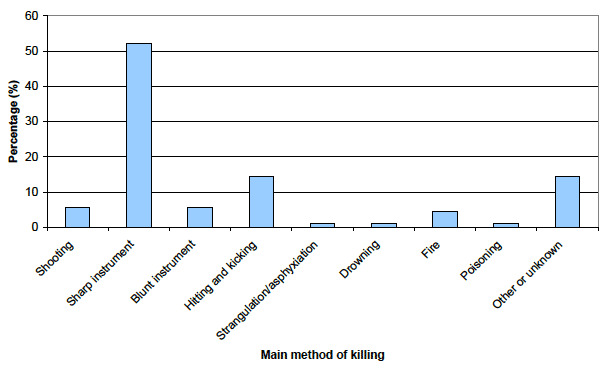
3.5 Relationship of main accused to victim (Tables 8, 9 and 10, and Charts 7 and 8)
- For 72 of the homicide victims recorded in 2011-12, the main accused was known to them either as an acquaintance, 60%, a partner or ex-partner, 14%, or a relative, 9%. Eight victims were killed by a stranger, 9% of all victims. For the remaining 7% of victims, the relationship of the main accused and victim in solved cases was unknown.
- Chart 8 presents the trends over the last ten years in the percentage of homicides for male and female victims by their relationship to the main accused. The highest percentage of male victims was consistently for those killed by an acquaintance. For female victims the largest percentage was almost always killed by a partner or ex-partner. There are more fluctuations in the percentage of the relationships of the accused to female victims due to the smaller number of female victims compared to male victims.
- A total of 61 children under the age of 16 years were victims of homicide between 2002-03 and 2011-12. Of these, 57% were killed by one of their parents. For the 20 victims aged under one year old, where there was an accused person, the main accused was either a parent (80%), other relative (15%), or the relationship between the victim and the accused was unknown (5%).
- For homicides recorded in the last ten years, 51% of the female victims aged between 16 and 70 years were killed by their partner or ex-partner, 29% were killed by an acquaintance and 9% were killed by a stranger. For male victims aged 16 to 70 years, only 6% were killed by their partner or ex-partner. Nearly two thirds, 64%, of male victims aged 16 to 70 years were killed by an acquaintance and 17% were killed by a stranger.
Chart 7: Victims of homicide by gender and relationship to main accused, where relationship known, Scotland, 2002-03 to 2011-12
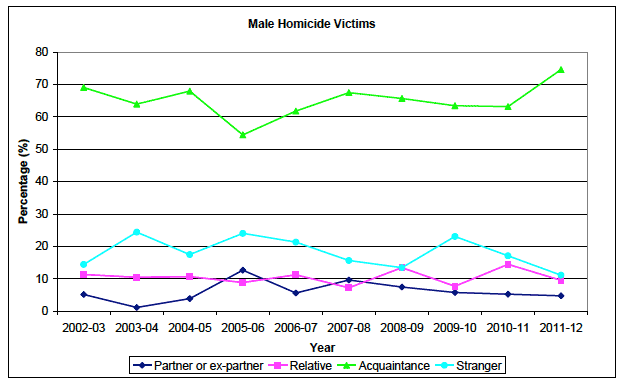
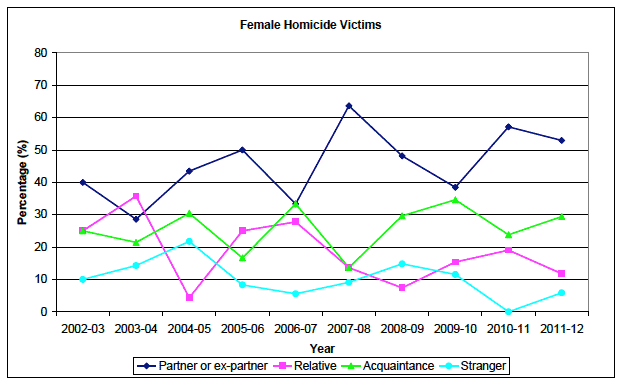
- Of the 32 people aged 71 and over, who were victims of homicide in the ten year period covered by this bulletin, 19 were female and 13 were male. Older people were most likely to be killed by either their son or daughter or a stranger, eight victims for each relationship category. Of the eight victims killed by their son or daughter, six were female. Acquaintances killed six older people, five of whom were male victims, and partners or ex-partners killed five older people, all of whom were female victims.
- The majority of solved homicide cases, 71%, recorded between 2002-03 and 2011-12 involved males killing males. Cases where the main accused and main victim were both female accounted for just 3% of the total number of homicide cases recorded in this period.
- Chart 8 shows a breakdown of the relationship, where the relationship is known, between the main accused and victim. In over two thirds of cases (70%) where a male was accused of killing another male, the victim and accused were acquaintances, whereas only 46% of females accused of killing another female were acquaintances. In 47% of cases where a female was accused of killing a male, the accused and victim were partners or ex-partners. This was also the relationship in 52% of cases where a male was accused of killing a female.
Chart 8: Relationship between main accused and victim, where relationship known, Scotland, 2002-03 to 2011-12
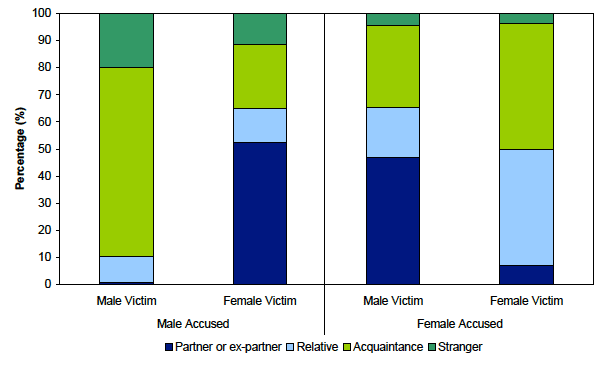
3.6 Main motive (Tables 11, 12, 13 and 14)
- The most common reasons recorded for committing homicide in the ten year period between 2002-03 and 2011-12, were fight or quarrel and rage or fury, with nearly half of all victims killed in such circumstances. In 2011-12, this figure was 42 victims (49%), 37 for whom the main motive was fight or quarrel.
- After fight or quarrel, 46% of male victims, the next most common known motive for killing male victims in 2011-12 was feud, faction rivalry, which was the motive for the killing of 10% of male victims. Given the small number of female victims of homicide in 2011-12 there was no clear pattern in the main motives of these homicides.
- In the period 2002-03 to 2011-12, 77% of all female victims were killed in dwellings, compared with 53% of males. The most common set of circumstances in which females become victims of homicide are in a dwelling, in a rage or fight with a partner or ex-partner, 18% of female victims in solved cases. Location is less of a factor for male victims, whose killings are more typically a result of a rage or fight with an acquaintance.
- Eight victims were reported to have been killed in drug-related homicide cases in 2011-12. Six of the eight victims were male. Two of the homicides recorded in 2011-12 were reported to have had a homophobic motivation, with both victims being male. There was only one homicide in 2011-12 where there was a racial motivation.
3.7 Alcohol and drug status (Tables 15, 16, and 17, and Chart 9)
- Over two thirds, 68%, of the total of 124 persons accused in homicide cases in 2011-12 were reported to have been drunk and/or under the influence of drugs at the time of the homicide. Of these 124, 72 (58%) were drunk, 5 (4%) were on drugs, and 7 (6%) were both drunk and on drugs. This represents 82% of accused persons for whom the drink/drug status was known. The drink/drug status of the accused was unknown for 21 persons, 17% of the total number of accused. Only 19 accused persons (15%) were reported to have been neither drunk nor under the influence of drugs at the time of the homicide.
- In the ten year period between 2002-03 and 2011-12, 51% of all accused were reported to have been drunk and/or under the influence of drugs at the time of the homicide. For males accused it was also 51%, but for females it was marginally higher at 55%. When looking at only accused persons for whom the alcohol and drug status was known, the percentages for all accused and males are again, both at 78%. The percentage for females is again marginally higher at 80%. The pattern across the different age groups is the same, with the exception of the under 16 age group. As can be expected within this age group, the percentage of accused persons reported to have been drunk and/or on drugs at the time of the homicide is lower, at 30%. When those accused whose alcohol and drug status was unknown are excluded the percentage increases to 48%.
- In 2011-12, three quarters of cases where the main accused was drunk and/or on drugs, the victim was also known to have been drunk and/or on drugs. Where the main motive for a homicide was a rage or fight, 93% of the main accused for whom the drink/drug status was known, were drunk and/or on drugs. In 84% of cases where the main accused was drunk and/or on drugs the victim was also drunk and/or on drugs at the time the homicide took place.
Chart 9: Alcohol and drug status of homicide accused, Scotland, 2011-12
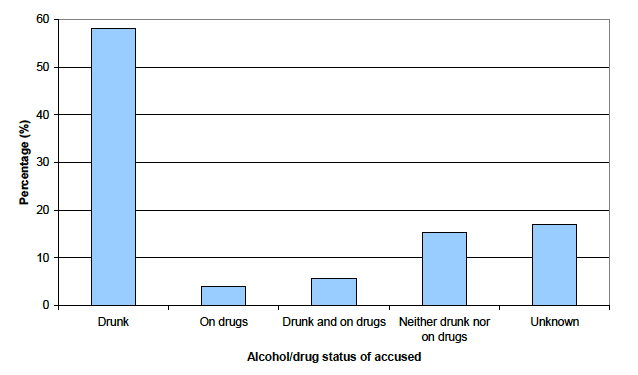
3.8 International comparisons of homicide rates (Table 18)
- A number of international organisations, including Eurostat, have attempted to collate international homicide statistics. It is important to note that there are issues surrounding the comparability of international homicide data. There are different definitions of homicide between countries, although definitions vary less than for some other types of crimes. Furthermore, there are differing points in criminal justice systems at which homicides are recorded, i.e. when the offence is discovered or following further investigation.
- Eurostat's most recently published figures compare homicide rates per 100,000 population averaged over the years 2007 to 2009. Table 17 contains the homicide rates per 100,000 population for the 27 European Union (EU) member states as well as the EU candidate states and the states that are part of the European Free Trade Association. In addition, the homicide rates for capital cities are also shown. Scotland's average homicide rate between 2007 and 2009 was 1.89 victims per 100,000 population. This was higher than the corresponding rates in England and Wales, 1.25 per 100,000 population and in Northern Ireland, 1.47 per 100,000 population. An average homicide rate of 1.89 victims per 100,000 population placed Scotland in the upper third of EU member states.
Contact
Email: Neil Henderson
There is a problem
Thanks for your feedback